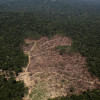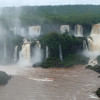Brazilian warplanes dump water on burning Amazon forest

Brazilian warplanes are dumping water on the burning forest in the Amazon state of Rondonia, responding to a global outcry over the destruction of the world’s largest tropical rain forest.
As of Sunday, President Jair Bolsonaro had authorized military operations in seven states to combat raging fires in the Amazon, responding to requests for assistance from their local governments, a spokeswoman for his office said.
Reuters accompanied a firefighting brigade near the state capital of Porto Velho, where there were areas larger than football fields that had been charred, but active fires were contained to small areas of individual trees.
The dozen or so yellow clad firefighters from environmental enforcement agency Ibama easily cleared brush from around a burning stump with a leaf blower, doused it with jets connected to water packs mounted on their backs and covered it in earth.
A video posted by the Defense Ministry on Saturday evening showed a military plane pumping thousands of liters (thousands of gallons) of water out of two giant jets as it passed through clouds of smoke close to the forest canopy.
The response comes as leaders of countries in the Group of Seven (G7) nations currently meeting in France expressed grave concerns over the fires.
French President Emmanuel Macron on Sunday said the G7 was nearing a deal to provide “technical and financial help” to countries affected by the Amazon fires.
Nearly 80,000 fires have been registered across Brazil through Aug. 24, the highest since at least 2013, according to space research agency INPE.
Bolsonaro announced the military would be sent in on Friday after several days of criticism from the public and world leaders that Brazil’s government was not doing anything to fight the fires.
He also said on Twitter he had accepted Israeli Prime Minister Benjamin Netanyahu’s offer of a plane and specialized support for the firefighting operations, following a call between the two leaders.
But outside of Rondonia, the government had yet to provide any operational details for other states. The Defense Ministry said in a briefing on Saturday that 44,000 troops were available in Brazil’s northern Amazon region but did not say how many would be used where and what they would do.
Military personnel around Porto Velho appeared to be largely coordinating firefighting efforts, according to a Reuters witness.
Asked for additional details, the Defense Ministry told Reuters in a statement that in all seven states that have asked for help, the military is planning operations to support firefighting initiatives already underway.
Justice Minister Sergio Moro had also authorized a force of military police to assist in fighting the fires, with 30 set to be sent from Brasilia to Porto Velho. The president’s office posted to Twitter a photo of police officers on a plane bound for Rondonia set to arrive at noon.
Environment Minister Ricardo Salles posted a video showing a caravan of yellow fire prevention trucks and other government vehicles, saying they were on the ground responding in Rondonia.
Colombian President Ivan Duque said on Sunday he would seek a conservation pact with other Amazonian countries - first in bi-lateral meetings in Peru this week and then at the United Nations General Assembly.
“Colombia wants to lead a pact, a conservation pact, between the countries that have Amazon territory,” Duque said after meeting with an indigenous community in the Amazonian city of Leticia in southern Colombia. “We must understand the protection of our Mother Earth and our Amazon is a duty, a moral duty.”
The Amazon is the world’s largest tropical rain forest and is seen as vital to the fight against climate change because of the vast amounts of carbon dioxide that it absorbs.
The Amazon, which provides 20% of the planet’s oxygen, is home to an estimated one million indigenous people from up to 500 tribes as well some three million species of plants and animals, including jaguars, sloths, giant otters, river dolphins, howler monkeys, toucans, reptiles, frogs and insects.
Brazilian climate scientist Carlos Nobre said he worries if 20-25% of the ecosystem is destroyed that the Amazon could reach a tipping point, after which it would enter a self-sustaining period of dieback as the forest converts to savannah. Nobre warned that it is not far off with already 15-17% of the rain forest having been destroyed.

 For all latest news, follow The Daily Star's Google News channel.
For all latest news, follow The Daily Star's Google News channel. 








Comments